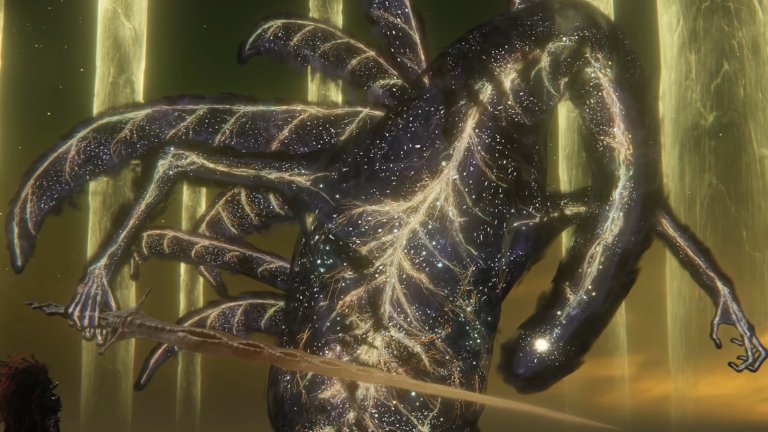Elden Ring They Didn't Seem Right

FromSoftware games tend to feature deep and intentionally confusing lore. Gamers and theorists are still trying to piece together the story and backstory of Nighttime Souls and Bloodborne , and Elden Ring continues that proud tradition by offer a narrative full of fascinating facts that are surprisingly easy to miss.
Elden Ring 's basic story is surprisingly straightforward: Players have to gather the Great Runes and reassemble the Elden Ring to become the next Elden Lord. Along the way, the histrion'south grapheme acquires a ton of equipment and occasionally bumps into potential allies. However, that driving narrative doesn't even scratch the surface of the game's lore. While much of Elden Band 's backstory was seemingly penned by George R.R. Martin, players will likely discover about of the game'south lore in the usual Soulsborne ways (i.e. item descriptions and vague character dialogue). It's not uncommon for players to overlook those crucial (or at to the lowest degree fascinating) bits of history and grapheme motivation but considering they didn't find some random trinket.
That being the case, here are some of the most jaw-dropping Elden Ring lore factoids that yous probable missed during your 100+ 60 minutes journeying through the game.
The Erdtree Wasn't the First Tree (and Might be a Parasite)
In Elden Ring , the Erdtree is the source of…well, everything. The gigantic glowing tree is the physical manifestation of the titular Elden Ring and is supposed to be the source of life in the Lands Between. Although, the truth of the Erdtree's origins is and then much darker than it seems. In fact, the Erdtree might really be an invasive species.
As players progress through Elden Ring , they will find a variety of crafting materials that include a foreign detail known equally Root Resin. The game is filled with items that originate from the Erdtree ( such as Golden Seeds and the Crimson Amber Medallion) but Root Resin isn't one of them. Co-ordinate to that item'southward description, it actually comes from "the roots of the Greattree," which were one time intertwined with the Erdtree. This entry could imply the two trees were siblings. Nevertheless, the Protection of the Erdtree Incantation states: "In the outset, everything was in opposition to the Erdtree." That flavor text suggests that the Erdtree isn't the genesis of The Lands Between as some suspected it might exist.
Actually, many other items support the idea that the Erdtree substantially invaded the Lands Between. For instance, Remembrance of the Dragonlord claims that its owner, Dragonlord Placidusax, was "Elden Lord in the historic period before the Erdtree," and the Elden Stars Incantation states that 1 of the Outer Gods, the Greater Will, seeded the Lands Between with a meteor that eventually resulted in the Elden Ring and the Erdtree by proxy. However, even with this knowledge, calling the Erdtree a parasite is still a bit of a stretch…at to the lowest degree until you visit the game's catacombs. Each of those dungeons is packed with roots that are besides filled with corpses. Moreover, Miquella'south Needle states information technology was created to "ward away the meddling of outer gods." Said Outer Gods would certainly seem to include the Greater Volition.
Fifty-fifty though the Greater Volition brought "order" to the Lands Between via the Erdtree and Elden Ring, the entity is conspicuously up to no good.
The Origins of the Underground Cities Nokron and Nokstella
The Lands Betwixt is total of beautiful landmarks, and the number of noteworthy vistas well-nigh doubles when players take into account the underground caves that hide mysterious biomes. Two such areas are the twin Eternal Cities of Nokron and Nokstella. Every actor who enters those secret citadels will inevitably wonder why these cities are underground. The answers to that question are scattered beyond item and spell descriptions.
The virtually obvious hint lies in the flavor text of the Nox Swordstress and Monk armor sets, which state that the residents of Nokron and Nokstella, the Nox, once "invoked the ire of the Greater Will, and were banished deep underground." So if the Greater Will is responsible, what did the Nox practise that drew the Outer God's attention? There are two possibilities.
I potential respond is the so-called "hidden treasure of the Eternal Metropolis of Nokron," the Fingerslayer bract. That weapon is supposed to damage the Greater Will and its "vassals," (i.e., the Elden Fauna). Information technology makes sense that the Greater Will would take offense to a weapon designed to kill it, likewise as the weapon's designers. Another possibility lies in the Silvery Tear enemies, which are metamorphic silver puddles that were supposedly created by the Nox to "forge a lord." The culmination of the Silverish Tear experiments was the Mimic Tear, which probable was the impetus behind the Nox'southward banishment.
Before I said that the Greater Will sank the Eternal Cities of Nokron and Nokstella, which plain explains why the cities concluded underground but non how the Greater Will managed to pull off that considerable feat. While 1 might be tempted to assume it was the meteor that eventually created the Elden Ring, it seems that the real culprit is actually Astel, Naturalborn of the Void. According to the beast's Remembrance, it was once a "malformed star" that "destroyed an Eternal City."
In other words, the Greater Volition nuked Nokron and/or Nokstella from orbit with a meteor that either was Astel or somewhen turned into information technology. Subtlety isn't exactly the Greater Will's forte.
How the Elden Ring Was Forged/Formed
The goal of Elden Ring is far more cutting and dry than other Soulsborne games: The titular Elden Ring has been shattered, and it's up to players to reforge information technology. Yet, that premise raises the question, "How was the Elden Ring formed in the commencement place, and what is so of import about it?" Did some Sauron-like figure forge it in times long forgotten in order to command mortal races? That semi-serious clarification is both inaccurate and accurate at the same time.
As we've already established, an Outer God known as the Greater Will shot a meteor into the Lands Betwixt that resulted in the growth of the Erdtree. However, the falling star wasn't an extraterrestrial seed. Co-ordinate to the Elden Stars Incantation, the meteor was actually a giant creature known only every bit the Elden Beast Moreover, the spell's flavor text states that the Elden Beast eventually became the Elden Band. Nobody knows the logistics of such a transformation, but at that place is i popular (and fascinating) theory that seems to offer something close to an explanation.
According to Elden Ring lore, Queen Marika the Eternal didn't wield the Elden Ring but was instead a "vessel" for it. Perhaps the Elden Ring isn't a purely concrete object and primarily "exists" so long as it is within someone. That might explain why the Elden Ring seemingly floats inside Radagon of the Aureate Society during his boss battle, equally well as why the true final boss, the Elden Animate being, crawls out of him immediately later on he dies. Without a host, the Elden Ring reverts back to its original form.
Of course, that still doesn't explain how Queen Marika shattered the Elden Ring and turned it into the Great Runes, but at to the lowest degree it gives a plausible explanation of how the ring was "forged" to begin with. Afterwards all, the Elden Ring controls the metaphysical laws of reality, including order and expiry itself. Why would such a powerful object be express to just a concrete course?
Read more than
Godfrey Is the First Tarnished
In Elden Ring , players assume the role of a Tarnished, a member of a banished people who had lost the Erdtree's grace. As with all factions, in that location's always a first, and while we know of famous (and infamous) electric current members such as Rogier and Patches, who started it all? Who was the get-go Tarnished? Ironically it was the first Elden Lord, Godfrey.
After players defeat Godfrey, they receive the Remembrance of Hoarah Loux (Hoarah Loux is Godfrey's real name), which tin can be scrapped for runes or traded for a unique weapon or Ash of War. If players choice the weapon, they receive the Axe of Godfrey, which states in no uncertain terms that Godfrey one time served equally the leader of the Tarnished and was there for their exodus. If players keep earthworks, they will discover that the Erdtree didn't carelessness Godfrey of its ain volition. Instead, Queen Marika the Eternal is to blame.
According to Godfrey's ain armor, he once fought the giants and the Storm Lord, only afterward he won, the colour of his optics dulled. Melina picks the story up from there. When players rest at the Third Church building of Marika, Melina recites Queen Marika's own words, saying that she "divested" Godfrey and his warriors of their grace, thus making them Tarnished. This claim is backed upwards by his Remembrance, which states he was "robbed of his grace" and became Tarnished.
All the same, Queen Marika didn't blackball her hubby out of spite. In her own words (again recited past Melina), she wanted the exile to help Godfrey and the Tarnished get stronger and claim the Elden Band for themselves. This trivial nugget has led many gamers to presume that Queen Marika is playing the long game and orchestrated numerous intertwining events in club to defeat the Greater Will.
Godwyn Isn't Really Expressionless
The lore of Elden Ring is even larger than the game's world. However, few Elden Ring lore events are as important every bit the Night of the Black Knives: the night when a cadre of assassins killed the son of Queen Marika and Godfrey, Godwyn the Golden. Godwyn was the first Demigod to ever dice in the Lands Between, which eventually resulted in the globe Elden Band players explore. Interestingly enough, though, it turns out Godwyn isn't really expressionless in the traditional sense of the word.
To understand why Godwyn's not-expiry is so important, we first have to examine the titular Elden Ring. The Ring is fabricated out of several Peachy Runes that govern reality. Remove 1 Rune from the Ring, and the rules of reality change. According to Finger Reader Enia, Queen Marika the Eternal removed the Rune of Death from the Elden Ring (this is confirmed by the Mending Rune of the Death-Prince), thus deleting the concept of Death. Nobody could die, at to the lowest degree not in the fashion nosotros understand it.
Somewhen, players learn that Ranni the Witch was the mastermind of the Night of Black Knives, and she admits to stealing a portion of the Rune of Expiry, which she used to kill herself and Godwyn. Of form, since players acquire this from Ranni, that means she didn't fully die. That besides ways that Godwyn never really died. The Cursemark of Death explains that since Ranni and Godwyn were killed at the same time, Ranni's trunk died simply her spirit lived on (which is why she now inhabits a doll). Meanwhile, Godwyn's spirit died, but his body did non. So what happened to his soulless husk? Odds are players establish it and never realized it.
Under Stormveil Castle, players can discover a behemothic, octopus-shaped face up with roots branching out. Next to the face is the Prince of Death's Pustule, which implies the face is actually that of Godwyn. Information technology really turns out that Godwyn'due south body has turned into something right out of a Junji Ito manga. Godwyn's soulless non-corpse has grown and spread along the Erdtree'south roots. Players can even find parts of his body in the Deeproot Depths.
While Godwyn'south body is so mutated that it is utterly unrecognizable, Elden Ring's lore indicates that he is still horrifically alive. Don't ask us how.
Source: https://www.denofgeek.com/games/elden-ring-lore-explained-facts-didnt-know/


0 Response to "Elden Ring They Didn't Seem Right"
Post a Comment